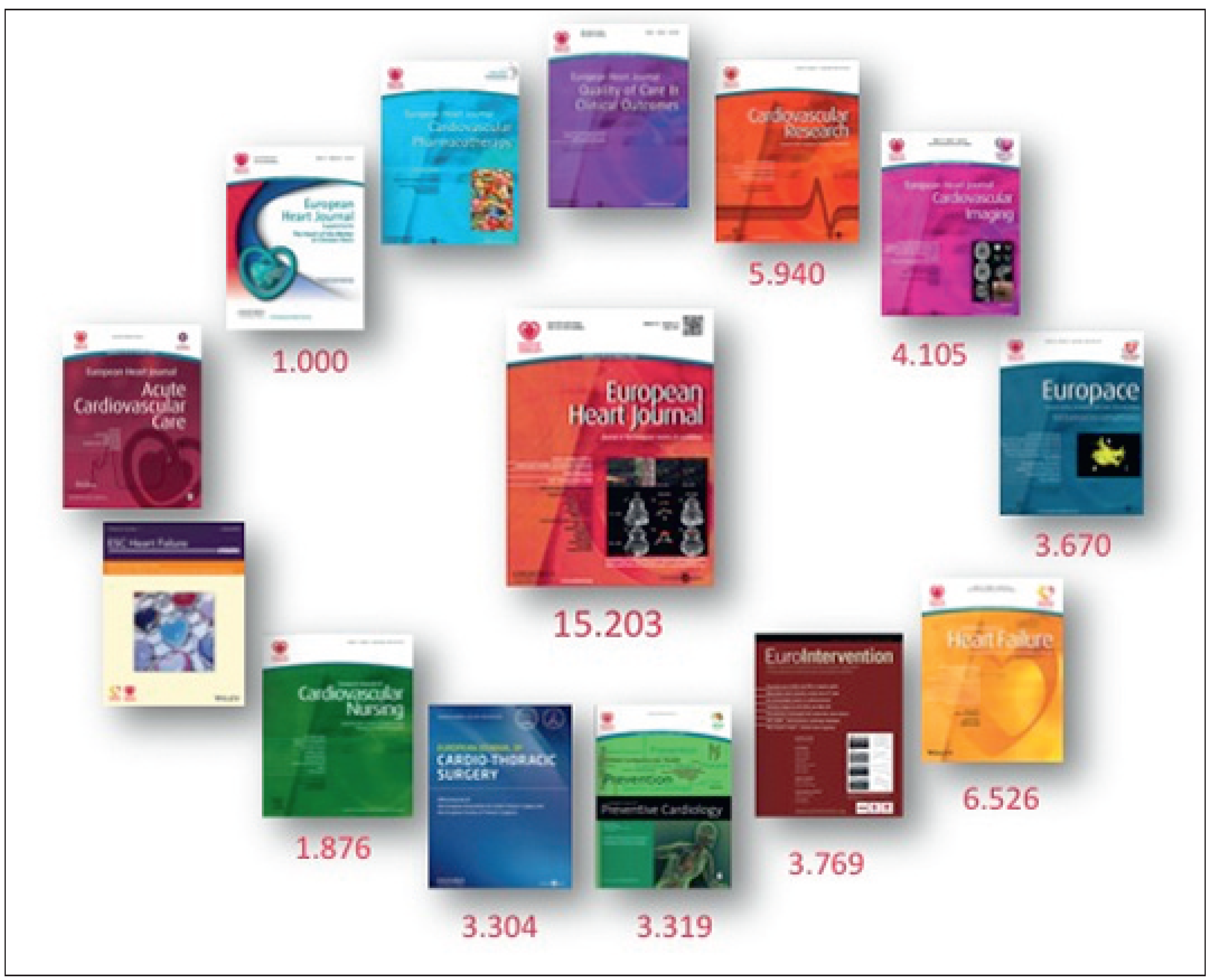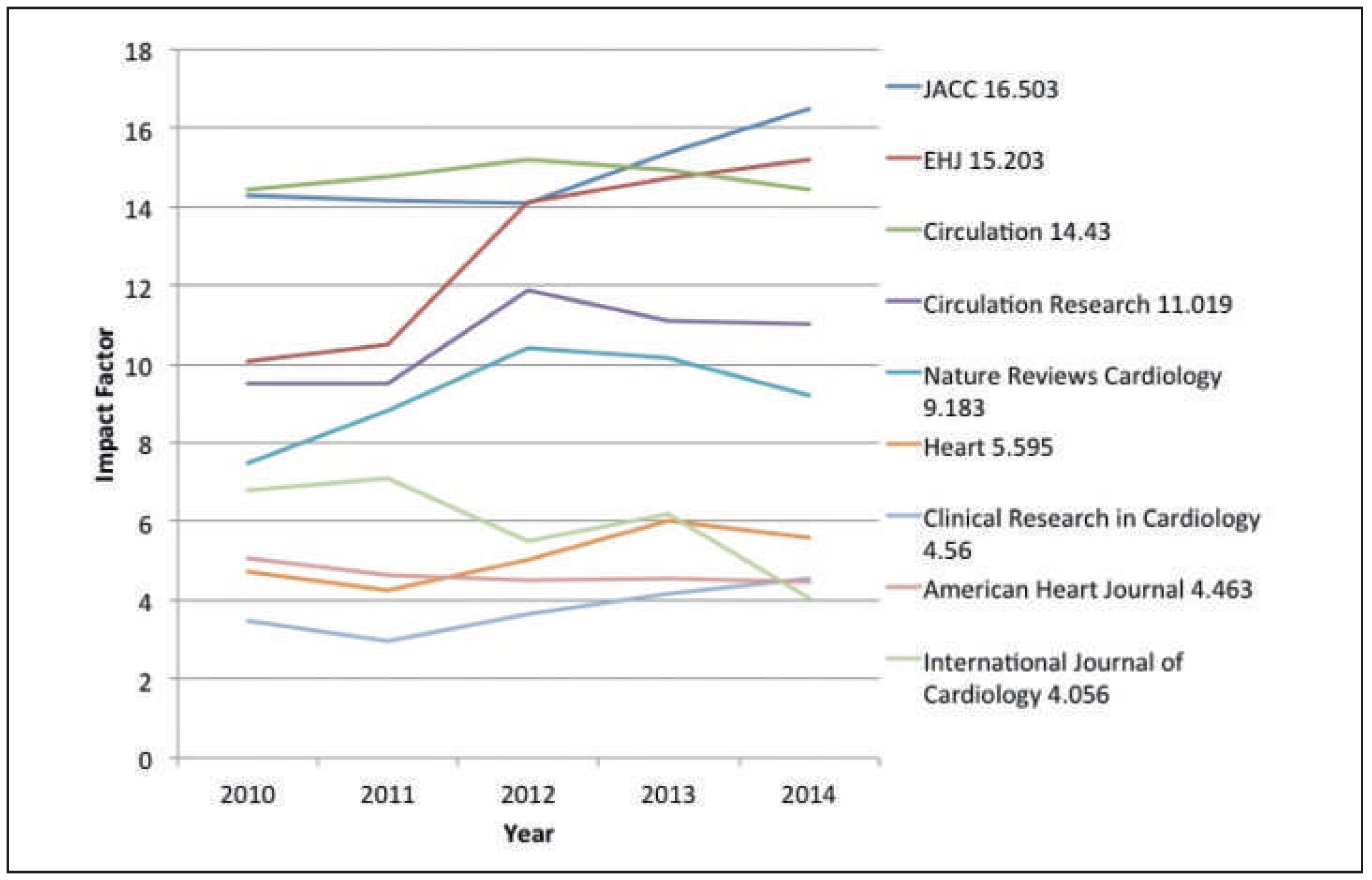The EHJ’s New Impact Factor is 15.2–Surpassing Circulation and Solid No. 2 Worldwide
The Beginning
A novel strategy
The growth of the ESC journal family
Influence and Impact
References
- Snellen, H.A. Birth and growth of the European Society of Cardiology. Eur Heart J. 1980, 1, 5–7. [Google Scholar] [CrossRef] [PubMed]
- Lüscher, T.F.; Brugada, J.; Gersh, B.J.; Landmesser, U.; Serruys, P.W.; Murphy, S.; Dedecke, S.; Rogers, S.; Ruschitzka, F. Happy birthday European Heart Journal: in 30 years from Cinderella to centre stage. Eur Heart J. 2010, 31, 1945–1950. [Google Scholar] [CrossRef] [PubMed]
- Lüscher, T.F.; Gersh, B.; Brugada, J.; Landmesser, U.; Ruschitzka, F.T.; Serruys, P.W. The European Heart Journal goes global. Eur Heart J. 2005, 30, 1–5. [Google Scholar] [CrossRef] [PubMed]
- Luscher, T.F.; Gersh, B.; Hendricks, G.; Landmesser, U.; Ruschitzka, F.; Wijns, W. The best of the European Heart Journal: look back with pride. Eur Heart J. 2012, 33, 1161–1171. [Google Scholar] [CrossRef] [PubMed]
- Lüscher, T.F.; Gersh, B.; Hindricks, G.; Landmesser, U.; Nallamothu, B.; Ruschitzka, F.; Wijns, W. The European Heart Journal on the move: can scientific publishing be further improved? Eur Heart J. 2013, 34, 409–415. [Google Scholar] [CrossRef] [PubMed]
- Luscher, T.F.; Ruschitzka, F.; Landmesser, U.; Voors, A.A.; van Gilst, W.H.; van Veldhuisen, D.J. The European Heart Journal and the European Journal of Heart Failure: partners in scientific publishing. European journal of heart failure. 2012, 14, 1075–1082. [Google Scholar] [CrossRef]
- Luscher, T.F. Good publishing practice. Eur Heart J. 2012, 33, 557–561. [Google Scholar] [CrossRef]
- Heinze, G.; Juni, P. An overview of the objectives of and the approaches to propensity score analyses. Eur Heart J. 2011, 32, 1704–1708. [Google Scholar] [CrossRef]
- Head, S.J.; Kaul, S.; Bogers, A.J.; Kappetein, A.P. Non-inferiority study design: lessons to be learned from cardiovascular trials. Eur Heart J. 2012, 33, 1318–1324. [Google Scholar] [CrossRef] [PubMed]
- Wolbers, M.; Koller, M.T.; Stel, V.S.; Schaer, B.; Jager, K.J.; Leffondre, K.; Heinze, G. Competing risks analyses: objectives and approaches. Eur Heart J. 2014, 35, 2936–2941. [Google Scholar] [CrossRef] [PubMed]
- Nallamothu, B.K.; Luscher, T.F. Moving from impact to influence: measurement and the changing role of medical journals. Eur Heart J. 2012, 33, 2892–2896. [Google Scholar] [CrossRef] [PubMed]




© 2015 by the author. Attribution - Non-Commercial - NoDerivatives 4.0.
Share and Cite
Lüscher, T.F.; Bax, J.J.; Dedecke, S.; Gersh, B.J.; Hindricks, G.; Huggler, J.; Landmesser, U.; Meier, A.; Rogers, S.; Ruschitzka, F.; et al. The EHJ’s New Impact Factor is 15.2–Surpassing Circulation and Solid No. 2 Worldwide. Cardiovasc. Med. 2015, 18, 231. https://doi.org/10.4414/cvm.2015.00349
Lüscher TF, Bax JJ, Dedecke S, Gersh BJ, Hindricks G, Huggler J, Landmesser U, Meier A, Rogers S, Ruschitzka F, et al. The EHJ’s New Impact Factor is 15.2–Surpassing Circulation and Solid No. 2 Worldwide. Cardiovascular Medicine. 2015; 18(7-8):231. https://doi.org/10.4414/cvm.2015.00349
Chicago/Turabian StyleLüscher, Thomas F., Jeroen J. Bax, Suzanne Dedecke, Bernard J. Gersh, Gerhard Hindricks, Johanna Huggler, Ulf Landmesser, Amelia Meier, Sam Rogers, Frank Ruschitzka, and et al. 2015. "The EHJ’s New Impact Factor is 15.2–Surpassing Circulation and Solid No. 2 Worldwide" Cardiovascular Medicine 18, no. 7-8: 231. https://doi.org/10.4414/cvm.2015.00349
APA StyleLüscher, T. F., Bax, J. J., Dedecke, S., Gersh, B. J., Hindricks, G., Huggler, J., Landmesser, U., Meier, A., Rogers, S., Ruschitzka, F., & Wijns, W. (2015). The EHJ’s New Impact Factor is 15.2–Surpassing Circulation and Solid No. 2 Worldwide. Cardiovascular Medicine, 18(7-8), 231. https://doi.org/10.4414/cvm.2015.00349



